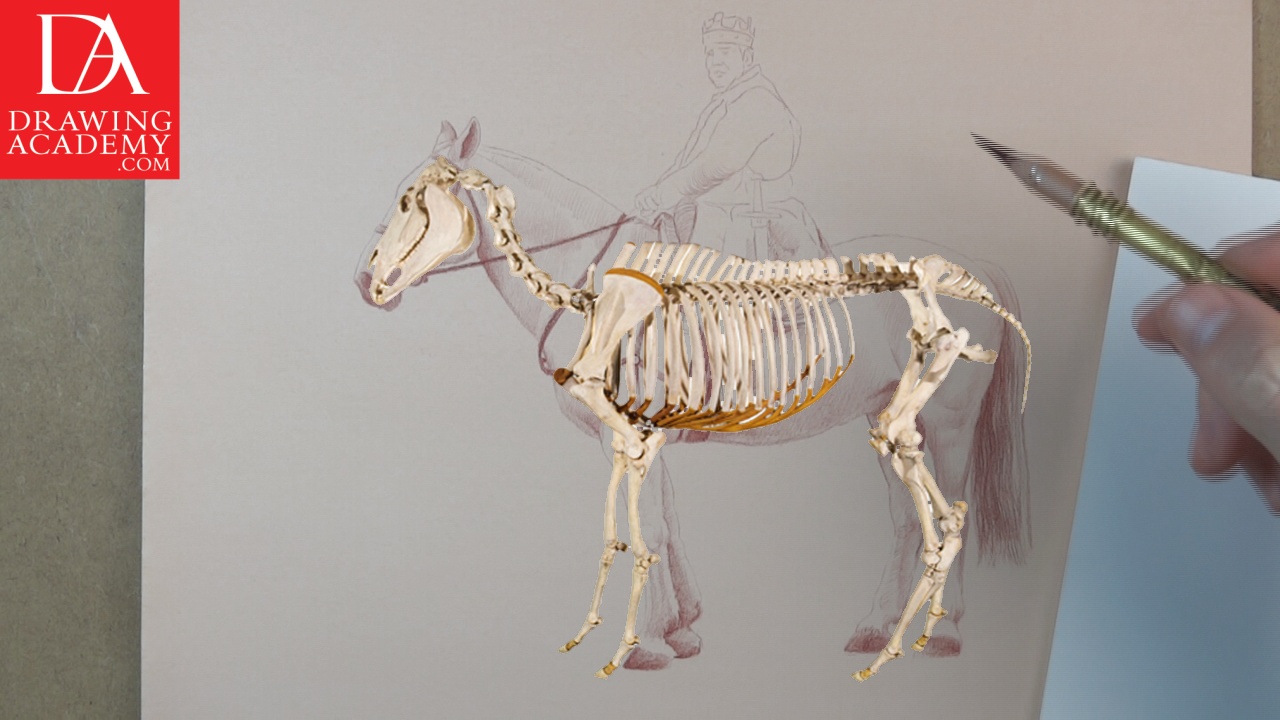Discover How to Draw Horses
In this video lesson you will discover How to Draw Horses in red pencil.
Enroll in the Drawing Academy Course
Pay once - Enjoy forever!
Only $297
How to Draw Horses and Other Animals
When it comes to How to Draw Horses and other animals in nature, such exercise can be limited to fast drawings, as they will not hold long poses. Making a lot of sketches is a great way to study horses; however, the knowledge of an animal’s anatomy is required to draw it realistically and with confidence.
How to Draw Horses – Animal’s Anatomy

Considering how to draw horses, fine artists must understand the construction of the animal. For example, a horse has similar shoulder elements to a human; however, the function of those elements is very different, which results in dissimilar shapes of bones.
A horse has a massive scapula or shoulder blade, short sternum and long radius, which make the shoulder structure look like the character “S”.
The field of its shoulder’s movement is much narrower compared to the human anatomy. A horse can only move its shoulder along one plane. The horse’s shoulder construction serves a vital function of amortization. It cushions the impact when the animal is running.
A horse’s shoulder blade has different proportions from the human scapula. Since it is much longer and more restricted in movement, it better supports the weight of the animal’s front part. The forces of muscles of the front limb are redistributed from narrow cross-section at the bottom to the wide area of the scapula at the top. This gives the horse very stable balance. A horse’s ribcage also helps it to keep its balance. The human ribcage is wider from side to side than from back to front. Another thing to consider when thinking how to draw horses, is that a horse have an opposite proportion of the ribcage. In combination with the shoulder structure, it allows these animals to sleep standing.
How to Draw Horses – Understanding Animal’s Mechanics
When it comes to the topic of ‘How to Draw Horses’, a fine artist shall be aware of animal’s mechanics. The hind limbs of a horse also have similar elements to the human anatomy. However, from a mechanical point of view, they are much better adapted to walking and running.
The horse’s pelvis is similar to a human’s bones, but once again, its function is very different. The human’s pelvis is wide and serves as a support for their abdominal internal organs. The horse’s pelvis does not support its stomach; instead it acts as structural part of its hind limbs.
A horse walks or run mostly with the power of its hind legs. Its front limbs support the front part of the animal. The movement forward goes as follows: A horse lifts up its front leg, for example the left one, then simultaneously pushes forward with its hind legs. With little delay, it also lifts its opposite right hind leg. Its front leg always goes slightly prior to its hind one. When its front limb goes up, it is accompanied with a nod of the horse’s head. When its front leg steps on the ground, the horse shifts its body weight on it. This is followed by its rear leg stepping down, which immediately is used to push its body forward. Then the process repeats with its right front and left hind legs.
Front legs are always directing the walking or running process. They start the walking and turn the animal in the required direction. Hind legs are the engine powering the movement, front ones are the rudder. This animal uses more of its intellectual power to steer its front legs, while its hind ones have a more automatic movement.
When galloping, the horse also uses its back muscles, in addition to, its leg muscles. This increases the power the animal uses for movement.
Horses also are able to amble run. This is when both front and hind legs of one side move simultaneously. Such running requires a certain speed to maintain that momentum of pace without swaying the body from side to side.





Comments are closed.